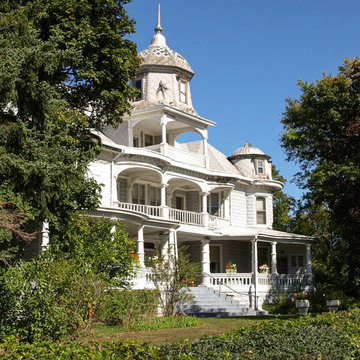The Israelite House of David religious commune was founded in 1903 on 130 acres adjacent to Benton Harbor by Benjamin Franklin Purnell. Purnell came to Detroit from Kentucky, then moved to Ohio, where he established a House of David commune in Fostoria, but he left for Benton Harbor because the townspeople were hostile toward his actions. The House of David was a continuation of a new millennium religious sect, which began in eighteenth-century England with Joanna Southcott's vision that she had been chosen to start preparing the world for the second coming of Christ. The sect was spread by the “Israelites” to the United States in 1844.
At Benton Harbor, the House of David practiced traditional Christian communitarian life. Its members surrendered their possessions to the group; abstained from meat, tobacco, and alcohol; practiced celibacy; and devoted their personal service to the work of the commune—all in return for daily sustenance, lodging, and the promise of heaven on earth when the time came. The colony was self-sufficient. It owned farmland, grew food, produced electricity, printed a newspaper, and made its own clothing and building materials. Its members were religious converts and former residents of Illinois, Ohio, Indiana, Kentucky, and Michigan. The House of David peaked at 1,000 members in the early 1920s.
On this site, colonists built houses, cottages, and a tabernacle. Two dormitories named Bethlehem (now demolished) and Jerusalem, built in 1904 and 1905–1906, respectively, were annexes to Shiloh House, the residence of King Ben, and they stood side by side on the north side of E. Britain Avenue, just west of Shiloh and connected to each other by an arcade. One architecturally notable structure was a three-story residential building called the Ark, built in 1903 on E. Britain Avenue between Fair Avenue and MI 139 and now demolished. Diamond House stands to the east behind the train station. The walls are made of large sparkling-concrete blocks manufactured of a patented recipe including hematite in a mold at the site by commune members. Shiloh is a large vernacular Queen Anne residence, built in 1908 by the commune's colonists. The wood used in its construction was logged from one of the islands owned by the commune in the Beaver Island archipelago. Reminiscent of the resort architecture that was built at the turn of the twentieth century along Michigan's shorelines, a veranda sweeps across the symmetrical facade and wraps around the side elevations, seemingly cinching the three-story corner towers to the building's square core. The central main entrance is surmounted by a triplet recessed porch at the second level and by a single ceremonial porch at the third, which, in turn, is capped by an eight-sided, bell-cast turret with a finial.
Catering to the thousands of tourists, many from Chicago, who traveled to southwestern Michigan by steamboat, the colony opened a Coney Island–style amusement park adjacent to the commune. It expanded restaurant facilities and built an amphitheater, where the House of David orchestra played for dances. A small train station, located across from the Jerusalem dormitory on the south side of E. Britain Avenue, once served as a passenger station for tourists wishing to ride on the miniature trains that traversed the House of David Amusement Park. The House of David received international attention for its traveling baseball team and its women's jazz band during the 1920s, as well as for its amusement park.
Scandals, a lawsuit, internal dissension, and the death of King Ben Purnell split the commune and its assets into two sects—the House of David led by Thomas Dewhirst and the City of David led by Mary Stollard Purnell, Purnell's widow. Today Queen Mary's City of David Museum (1158 E. Britain Avenue) is undergoing restoration, displays memorabilia, and offers tours.















